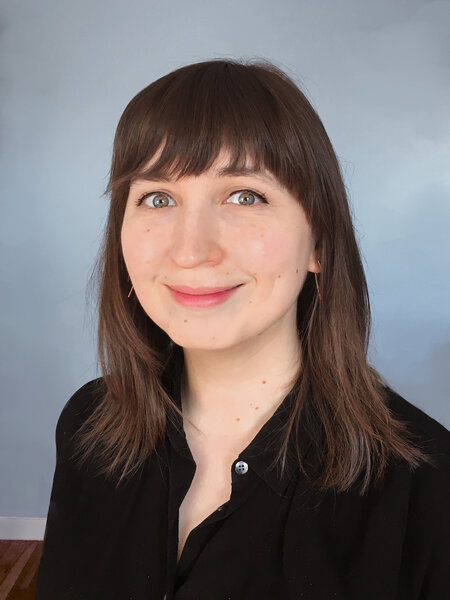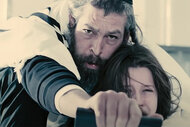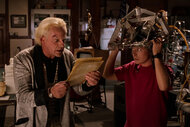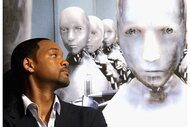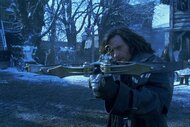Create a free profile to get unlimited access to exclusive videos, sweepstakes, and more!
The McElroys and The Adventure Zone ride again with 'Murder on the Rockport Limited'
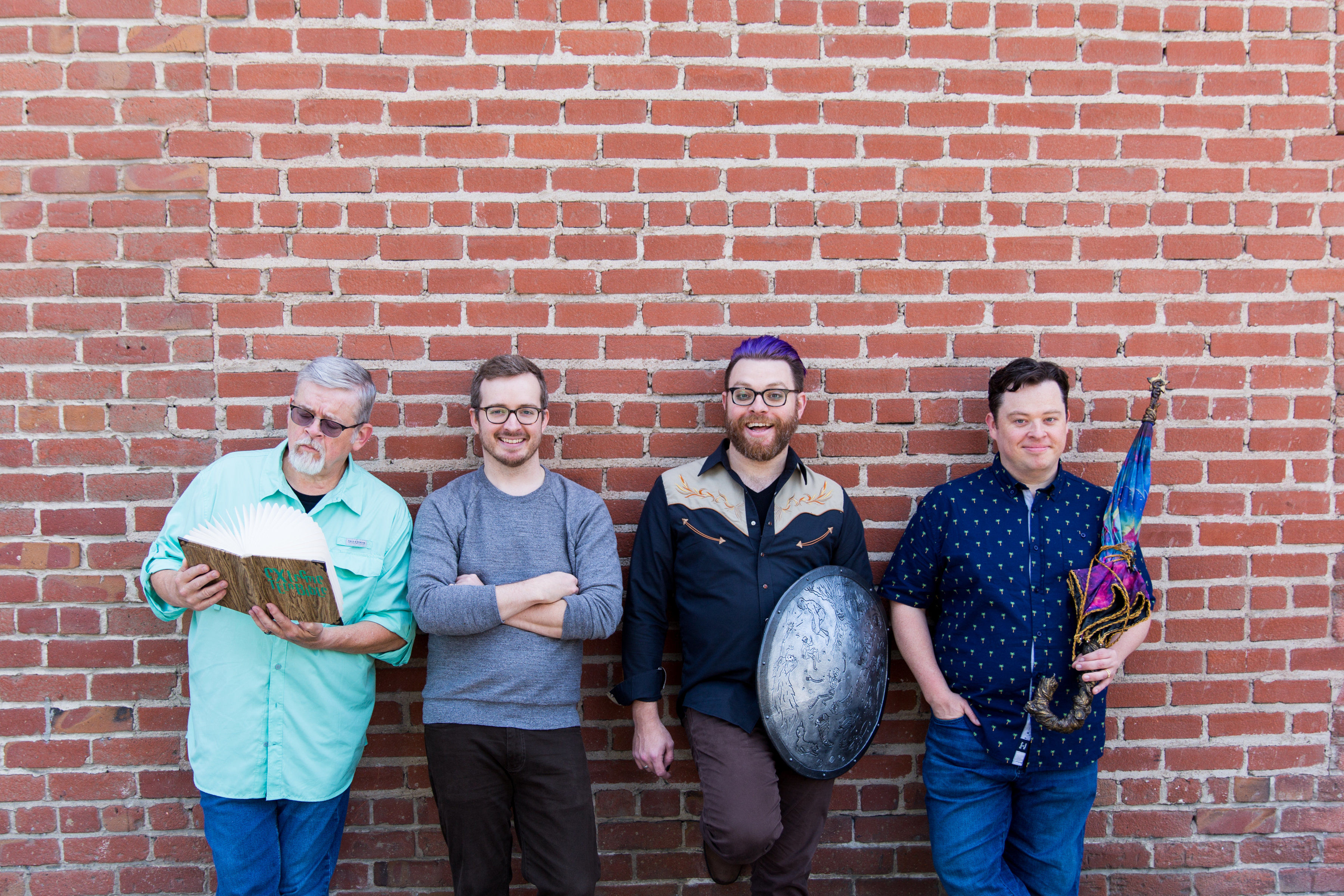
This time last year brought us the release of Here There Be Gerblins, a graphic novel of the first arc from The Adventure Zone. The popular podcast from Clint, Griffin, Justin, and Travis McElroy got the print treatment thanks to artist Carey Pietsch, First Second Books — and, of course, the McElroys themselves. Upon release, Here There Be Gerblins became the first-ever graphic novel to become number one on the New York Times best-sellers trade fiction list. On July 16, the characters we know and love as the Tres Horny boys will ride again — this time on the Rockport Limited.
The second arc of The Adventure Zone's "Balance" story was a game changer in many ways. Gerblins was a game included with the starter set of Dungeons & Dragons Fifth Edition, whereas Rockport was the first arc created entirely by Griffin as Dungeon Master, and introduced beloved characters like Angus McDonald and Garfield the Deals Warlock.
SYFY FANGRRLS spoke to Griffin, Justin, and Pietsch about bringing Murder on the Rockport Limited to the page and lessons learned along the way.
In the last book, we saw a little bit of it, but this is the first time we're getting to really immerse ourselves in the Bureau of Balance, getting to see the Void Fish and these characters that we're going to come to know and love. What went into that and devising what this home base would look like?
Griffin: Seen from the writing side, it was actually kind of tricky because, and I forget about this a lot, technically there is an arc of the podcast between Here There Be Gerblins and Murder on the Rockport Limited. It is called Moonlighting, I believe, and it was three episodes. It was where we introduce the Bureau and their mission statement and how they operate and what the boys' missions are going to be. There's a whole test of initiation sequence and all of this stuff that we had to either cut or condense into just the beginning of this book. So we definitely wanted to hit all of these things that are important about the Bureau of Balance because, like you said, they are an integral part of the story for the rest of the campaign.
We also have another whole arc's worth of story to tell, so we couldn't spend the first half of the book on the lunar base, introducing all of these characters that then you won't see again for the rest of the book, because they don't come with you on the adventure but are just going to be back every book or so. We definitely knew it was important, and I think definitely more attention and care went into the design of the moon base and the visual interpretation of that from all of us than a lot of other settings. Because this is a place we're going to come back to, and it just needed to be sort of coherent and perfect.
Carey: We all spent a lot of time talking through what visual cues were important for the base itself, like how clean of a look we wanted it to be and how much of an open grassy area. I think some of that is also working backwards from what elements become important later in the podcast. We kind of have the benefit of full hindsight — like the McElroys have completed [that campaign], so we know where buildings need to be. We know that there have to be trees on the quad somewhere. And you can kind of work backwards from there. This is Bureau of Balance-adjacent, but I remember having a lot of conversations about the uniforms that the folks just strolling around the Bureau of Balance, what they wear might look like, and one thing we tossed around early that Clint and I talked about was "What if they were just all leather motorcycle jackets that just looked like the BoB logo?" Unfortunately, that is not the direction we went. I do like these kind of drapey tunics, but maybe we'll work the leather jackets back in someday.
One thing that I hadn't actually thought about until I was looking at this book is there's this inherent need for a consistent look, like the way you showcase class information and describing the items they get along the way. Did that conversation come to mind during Gerblins? That this way of doing things would need to be consistent across multiple books going forward, or did it just kind of work out that that format did the job?
Griffin: It is a thing that we all knew was going to be important, because we were optimistic that we would get to do more than one of these books. And it would be very confusing, especially to the reader of the book who doesn't know about the podcast, if things changed dramatically.
Carey: We definitely talked a lot about how to incorporate elements of tabletop games and how much of that to include at all, and I really liked the balance we landed on of having these, specifically, the character and item and cell sheets as a way to bring some of the humor and tone in without taking a whole side step away from the story to explain literally how a cell plays out. I think a lot of the consistency of that look is being able to work with the same letterer for both books, which I am really happy we got to do. Tess Stone, who works on the comic Not Drunk Enough, is a brilliant cartoonist who has such a great sense of making hand lettering really work with the artwork, and I feel really lucky to have gotten to work with him on those sheets in particular.
That leads into something that I was curious about. Last time we talked about the challenges of taking something that is essentially long-form improv and turning it into a narrative story, but in terms of taking the game mechanics and turning that into a part of the narrative, was that a challenge, or was that an opportunity to find fun new ways of storytelling?
Griffin: I feel like that was challenging the first handful of times that we had to cross that bridge, which was mostly in Here There Be Gerblins. We had to have this exact conversation for a lot of things, like how much of ourselves do we want to incorporate? How much real-world referential humor do we want to incorporate, because that stuff plays in the podcast and people know it's us talking, but it doesn't play as well if it's a fantasy elven dwarf talking about it. This conversation of how much game stuff do we want to include in the book — and we definitely wanted to have some version of it because it was a story we told by playing Dungeons & Dragons and we thought that that was important to acknowledge — but we only wanted to include stuff like that in situations where it impacted either the narrative or the humor directly.
We don't want to include rolls every time Magnus, Merle, Taako, or somebody casts a spell or something like that, because that would be really really grating after a while. But if Merle's trying to cast a spell that he doesn't know breaks the rules of the game, which it does, but it's funny in some way, maybe we will incorporate that.
Justin: It's also worth remembering that something like a dice roll in a role-playing game or an improvised comedy podcast can be thrilling and funny and exciting because it's a prompt in that moment. But the book is scripted from beginning to end, so using dice rolls as a narrative shorthand feels very arbitrary. Because we made it up, right? We wrote it. We could put whatever dice roll we wanted into it, and I think as a reader leaning on that too much would be really unsatisfying, because it's like, 'Well, you guys could've picked any number there.' Whereas when we're doing it live, we're at the hands of fate and therefore making it up as we go.
I feel like you guys have found a really good balance between spoilers versus foreshadowing. This book is very clearly not just written for fans who know what's coming, but it also does manage to serve that audience. There's one moment, in particular, it's right after the umbra staff, and the director is clearly upset and hurt. How did you determine what would be good to foreshadow without giving too much away?
Griffin: That has been especially as we move forward with Rockport I feel like the grand arc stuff starts becoming a thing that we now have to consider while we adapt it. We had to do some of that stuff in Book 1, but honestly a lot of the macro story stuff that we touched on there we sort of made up because we just wanted to have the bigger story that we would have some footprint in each of the books. But starting in Book 2, that's where we started talking about this stuff in the podcast. And I feel like if we just adapted it directly, I don't think we would spoil anything, but we have this huge opportunity now to make that a bigger story and make those hints more revealing. More explicit in some ways and provide more of a map to the big surprises closer to the end of the story. This is a conversation that we are having a lot, like what can we do to introduce this stuff earlier than five minutes before the climax of the show? What can we do to flesh out the bigger story without completely giving it away? And we've made pretty huge changes to drafts of the story trying to get that stuff across.
The scene you talked about in particular, that's my favorite scene in the whole book, and it's an entirely new thing. And it had to happen. Our editor, Allie, pointed out this is a huge deal — why wouldn't she have some sort of reaction to that? It's one of many opportunities we've had to take a look at that question and try to answer it in a way that doesn't give up the whole thing.
Gerblins was obviously, at least initially, an out-of-the-box game, whereas this is when you first launched into really creating your own story. Did that impact the writing of the book itself? This book feels more open-world, it's gorgeous. Gerblins was too, but this one is just beautiful. It feels like there's just a wider world.
Griffin: I agree. It's a beautiful, beautiful book. It was freeing in a sense, I mean from a mechanical sense, obviously, we made some changes in Here There Be Gerblins to the names of things because it was an out-of-the-box story when we started. It was the Lost Mines of Phandelver, I believe, which comes with the starter set, and then we moved away from that about two episodes in, but it still provided the backbone of what that first arc was. Adapting the first book, there were some considerations to having this be not necessarily infringing on the Lost Mines of Phandelver and the good work that the folks of Wizards have done on that. We didn't have to do that so much in this book aside from trying to figure out what to do about ... in our podcast, we had this joke that is so wild where everybody in this town looks exactly like Tom Bodett, but can we say Tom Bodett's name in the book? I do not know. I do not remember what we landed on there. So that was obviously a consideration, but in general, it was easier to adapt this book because it didn't shift halfway through in the way that Gerblins did. It was more coherent, we had a much straighter line from start to finish, and I feel like that was really helpful in adapting it.
Carey, can you talk a little bit about some of the elements that become truly iconic within the whole campaign? Like the Void Fish turned out so beautiful. I think there's going to be a lot of tattoos based off of this art. But also Garfield, and of course Angus. What was the process of coming up with art for these characters and these pieces that mean a lot to people already?
Carey: Well, thank you so much, Courtney. I think I felt really lucky that this whole thing really has been a collaborative process both in terms of the entire graphic novel team is building on this podcast that the McElroys have already completed. So they can work with hindsight knowing where their characters are going, and how that might inform things like their body language and how they act and look on the page now. From the very beginning, we've all been able to sit down together and talk about what everybody had in mind for what these characters and moments might look like, and the other thing that's been a huge advantage is being able to go back and listen to the podcast and try to remember how it felt to listen to that the first time. As a listener before we ever started on the graphic novels, how can I carry that kind of tone and emotion that all the McElroys have brought to the initial podcast into the graphic novel? Because so much of that is a translation. It's not creating from whole cloth, it's working to incorporate and build with the voice acting that they've already put into these characters.
You mentioned a wider world, and that's one of the things I love about Rockport, that very literally we get to see a bigger portion of the land that they're journeying through. I think I joked a little about being scared of a bottle episode — how do you keep things visually interesting when they are just on this train forever? One of the ways that I tricked myself into staying interested was to make larger moments out of these little peeks at the outside scenery, coming up with some wilder fantasy settings that we only get to see for these brief minutes to try to hint at the larger world that we really do get to see through the tone of the podcast and through the music that has always been a huge part of the show.
I want to talk about Garfield real quick, just because there's been so much talk about we'll never know what Garfield looks like, what his true form is, and this book really carried through with it. What did you guys do to determine how you would show this character?
Griffin: We all collaborated on designs like this. I think Carey's first one, we saw it and the verdict was "Less detail. Less explicit. Less." And then in the second, it was like "No, I don't want a hint of face. Enshroud your art," and so this version of Garfield is less explicit than the earlier design. Garfield was tough one to land because it's hard enough saying, "Hey, the podcast doesn't have this." The podcast is an audio medium, so it's "Make a visual component for it but also don't make a visual component for this one. You don't understand! Draw this character that we only did an audio version of, but don't draw the character!" It was a unique challenge that we put in front of ourselves.
Carey: Yeah, I got to say, I don't care for the phrase "explicit Garfield," but that does kind of sum up what we were trying to avoid.
Well if you Google that phrase you guys come up anyway so ...
Carey: Oh no. Oh dear. OK. And the other challenges, like "OK, we've gotten to that point, then how do we make this character expressive? What can we do with thin shreds of facial expression and emotion left to us to make this character?" So I think we got it. I like where Garfield ended up.
Was there anything you learned from Gerblins that you brought into this one? Things that you decided, "OK, you know what, we're going to do this differently this time." Basically, what did you learn from the last book that made this one an easier or a better process?
Justin: Everything. Yeah.
Griffin: There were questions about what was important to carry over and so, us as characters. Us — Justin, Travis, and Griffin — as characters. How much of the game do we want to incorporate in the book? What does the world look like? All of these questions, they had no answers when we started doing this, and that's why it took us so long to get the first book done, and that work really did lay the foundation for this and hopefully all the books moving forward. There were all of these tricky tightrope walks of "How do we maintain the humor of the podcast while also cutting a lot of referential stuff that doesn't play in a book? How do we make it a funny book while still trying to get across the emotional moments that we tried to do in the show?" All of these questions we kind of had answers for, and so it made making Book 2 incalculably easier than Book 1.
Justin: That is actually very close to my experience. The whole thing was a lot easier, but it's just from the groundwork that we laid in the long, long discussions after the first book. A lot easier to adapt because it's our story from the beginning, so I think it's a lot more coherent.
Griffin: There was also a confidence that I feel like we all had with this book that I just personally did not have with the first, because I had never done anything like this before. But we were so proud of what we ended up with that I feel like in shaping the second book, we all felt more comfortable putting a hand on the ball and suggesting changes where they needed to be, whereas in the first book we were all flying without a net.
Carey: Not only were we better at making this thing, but we had the knowledge that we had done it once before. Which is a nice little thing to hold up against whatever combo of voices we have in our own brains that say, "You won't be able to do this," and the answer is, "Well, we did it once, so that's pretty solid evidence that we can do it again."
Murder on the Rockport Limited releases July 16.
